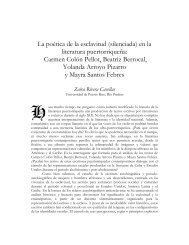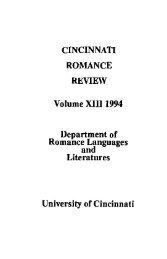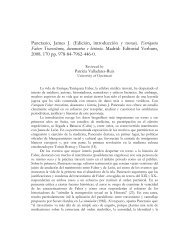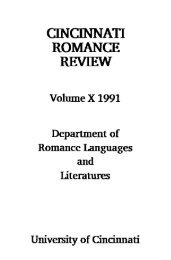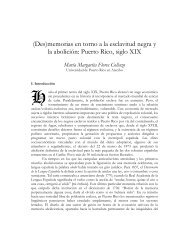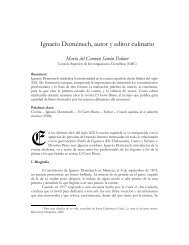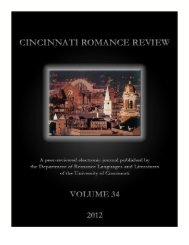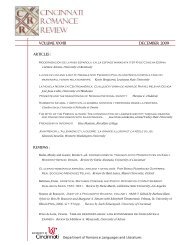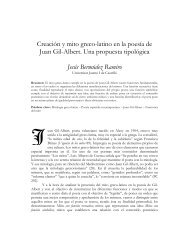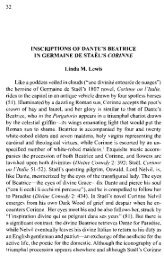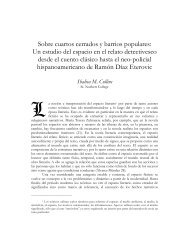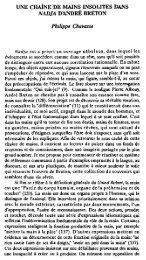Volume 30 (2011) - Cincinnati Romance Review
Volume 30 (2011) - Cincinnati Romance Review
Volume 30 (2011) - Cincinnati Romance Review
You also want an ePaper? Increase the reach of your titles
YUMPU automatically turns print PDFs into web optimized ePapers that Google loves.
“DOUBLE CONSCIOUSNESS/DOUBLE BIND” 77<br />
Carmen Colón Pellot was born (1911-2001) in Arecibo, located in the Northern<br />
Coastal Valley of Puerto Rico and struggled with not only her blackness but also her<br />
inferior status as a black woman in a white world. Her views on race relations and race<br />
are often contradictory and echo her existence as a light mulata in a color conscious<br />
society. In the prologue to her sole published book of poetry Ámbar mulato (1938), she<br />
notes that in Puerto Rico “...no existe el tipo de ‘negro perfecto’ supersticioso y ñáñigo.<br />
Nuestra población actual es jíbara veteada de sangre mulata” (Colón Pellot, “Prólogo”).<br />
While she identifies as a mulata, her description of Puerto Rican society echoes that of<br />
the national rhetoric which promoted its jíbaro or indigenous roots.<br />
In “¡Ay, señor que yo quiero ser blanca!,” subtitled a mulatto prayer, the poetspeaker<br />
confesses that she wants to be “rubia y blanca/como la espuma/como la<br />
charca/como las flores/de los naranjos/ de mis montañas”(45). In this poem the white<br />
woman and by extension whiteness is associated with virginity, beauty, and purity. The<br />
association of whiteness with purity, goodness, and chastity is a literary trope that<br />
permeates Hispanic literature and is omnipresent in the literature of Afro-Hispanic<br />
writers; this poem coincides with other Afro-Hispanic texts written during the<br />
nineteenth and early twentieth century that elevated whiteness. 3 Afro-Panamanian<br />
writers such as Federico Escobar (1861-1912) and Gaspar Octavio Hernández (1893-<br />
1918) for example, elevated whiteness at the expense of their own Afro-Latin identity to<br />
coincide with the national imaginary. 4 While Colón Pellot professed a mulata<br />
consciousness as evidenced by the title of her book, as Claudette Williams notes, the<br />
poet’s works often evoke ambivalence about her racial heritage and particularly her<br />
status as a woman of color in a white world. In “Motivos de envidia mulata,” the poetspeaker<br />
professes envy for her white female counterpart. In the first stanza, the poetspeaker<br />
muses,<br />
Tengo envidia de ti,<br />
nube blanca;<br />
te enamoras en brazos<br />
del viento;<br />
______________________<br />
3 In “Cultural Strangulation: Black Literature and the White Aesthetic”, Addison Gayle notes<br />
that “[t]he distinction between whiteness as beautiful (good) and blackness as ugly (evil) appears early in<br />
the literature of the middle ages-in the Morality Plays of England” (34). In “Black Phobia and the White<br />
Aesthetic in Spanish American Literature,” Richard Jackson notes how Spanish authors such as Lope de<br />
Rueda utilized this same dichotomy in their works (Eufemia 1576); this influenced the writings of Spanish<br />
American authors such as Gertrudis Gómez de Avellaneda (Sab 1841) and Cirilo Villaverde (Cecilia Valdés<br />
1882) who portrayed their black protagonists with white features (467).<br />
4 For information on literary whiteness in Panama see, Sonja Stephenson Watson’s “Nationalist<br />
Rhetoric and Suppression of Black Consciousness: Literary Whiteness in Poems by Federico Escobar and<br />
Gaspar Octavio Hernández” (2010).<br />
<strong>Cincinnati</strong> <strong>Romance</strong> <strong>Review</strong> <strong>30</strong> (Winter <strong>2011</strong>): 69-82.



